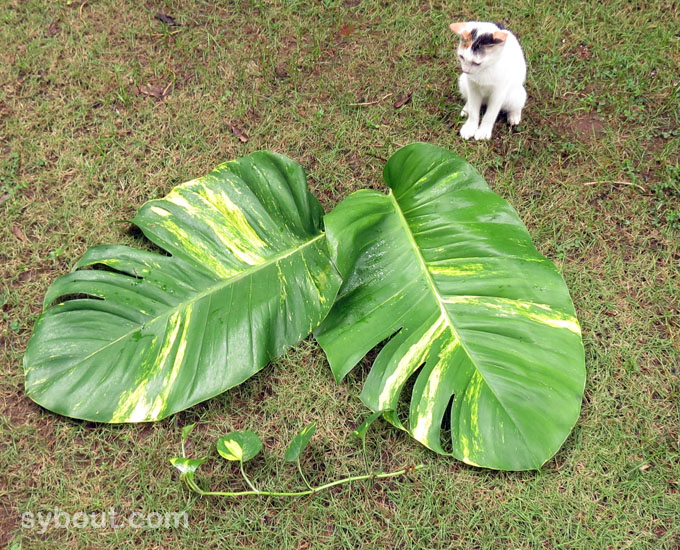Swiss Cheese Plant
Latin: Monstera deliciosa
Family: Araceae
English: Swiss Cheese Plant, Swiss Cheese Vine, Split-leaf Philodendron, Huricane Plant, Mexican Breadfruit
Indonesian: Daun Jendela Besar
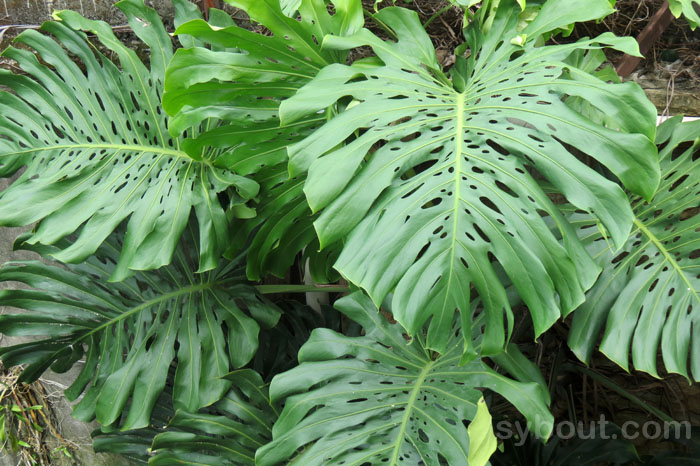
Since long this plant
has been one of my favorites. Already as a child I was fascinated by
its large dark green leaves with holes. Young plants have simple
heart-shaped leaves, but the larger the plant grows, the more cut and perforated
its leaves become. Though Monstera deliciosa often is grown in pots with light soil, it
actually is an epiphytic climber. It likes a shady humid environment. With good support like a wall or big tree, it will reach great height.
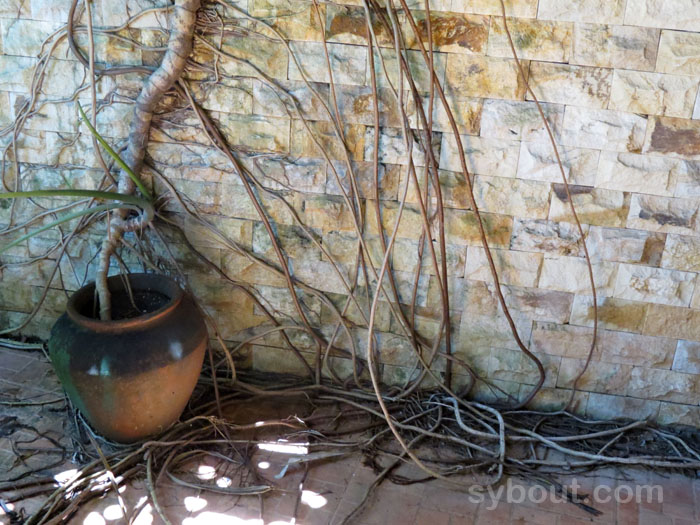
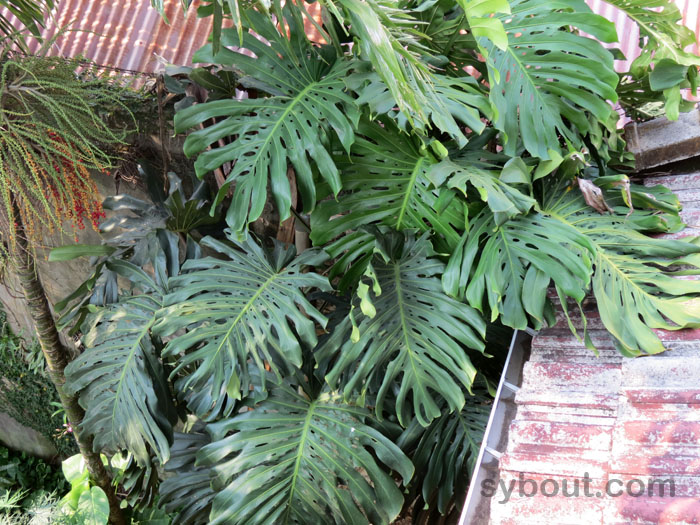
The mother plant in my garden has grown already a long time ago out of its pot and is about 4 meters high, what is still very moderate. The size of its leaves is about 1 meter by 75 cm. A part of its aerial roots stick to the wall behind it, others spread up to several meters across the terrace around. Some of the roots enter the soil in the garden bed next to the terrace. The plant can grow up to 10 meters high and probably more, but for this my garden lacks a shady place with support.
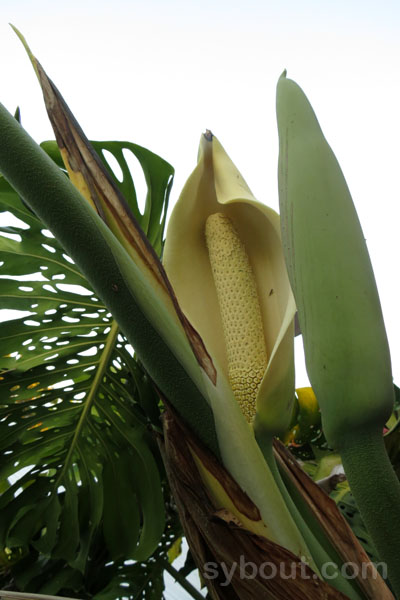
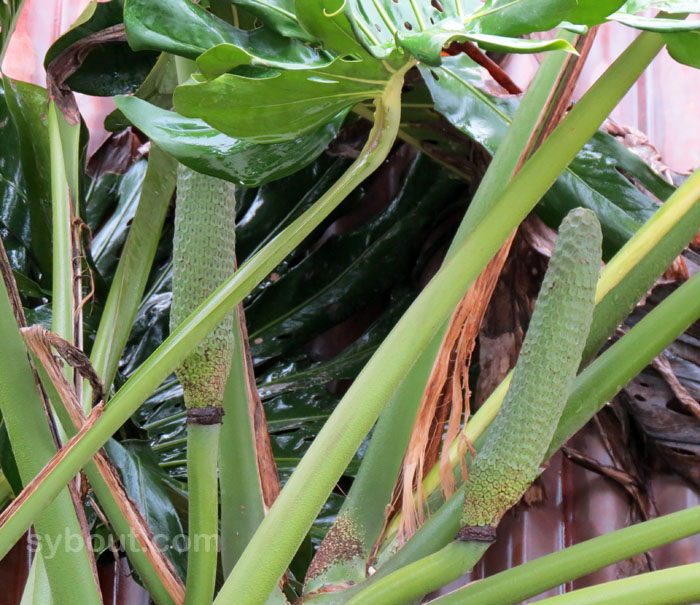
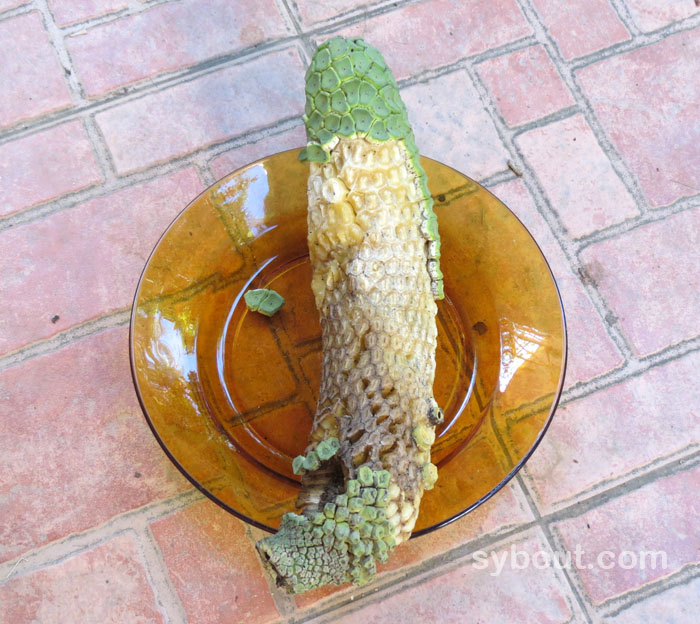
Older plants will produce creamy-white flowers with a pleasant fragrance. The flowers will turn into about 30cm long green fleshy fruits that are edible and taste like a cross of pineapple and banana. Eating the fruit is a bit tricky, as it should be really ripe. Unripe or half-ripe fruits contain oxalic acid which causes severe throat and skin irritation. You can tell that a fruit (or part of a fruit) is ripe when the scales come off easy. And yes, as the name "deliciosa" indicates, it tastes nice.
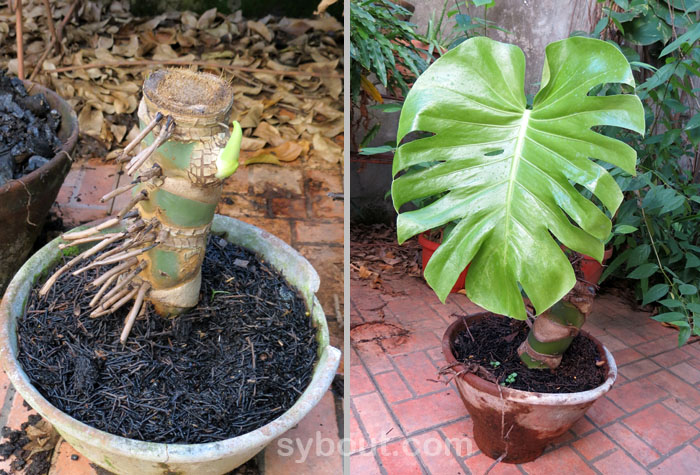
Propagation can be done by seeds or stem cuttings. Stem cuttings will result quickly in a plant with big leaves. Place the cutting in a pot with good draining soil or an other medium like rice husks. Keep the soil moist. After 2 - 3 weeks the first leaf bud will appear. The first leaf usually is relatively small and has no or only a few splits. When the plants get enough light the following leaves will be bigger with more splits and with holes (fenestrations) as well. The stem cutting in the photo above actually could have been far smaller. By cutting more "economically" the stem piece could have resulted in at least two new plants.
Five Holes Plant
Latin: Monstera adansonii
Family: Araceae
English: Monkey Mask, Window Leaf Monstera, Five Holes Plant, Adanson's Monstera
Indonesian: Janda bolong, Daun jendela kecil
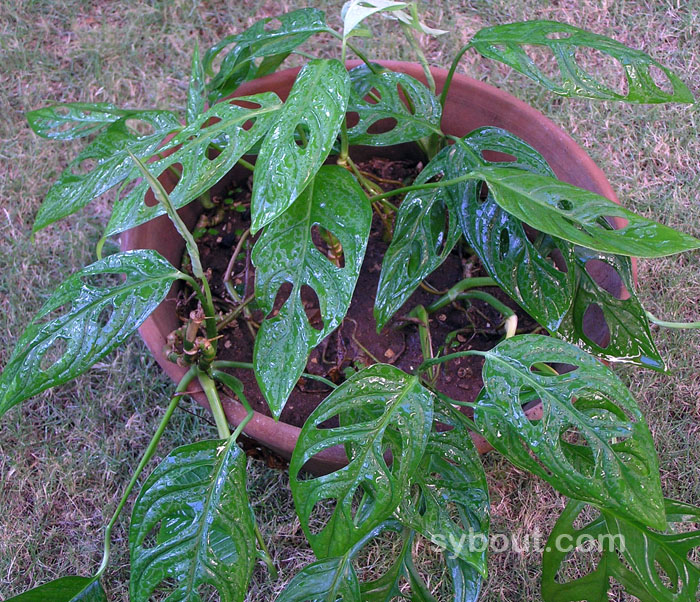
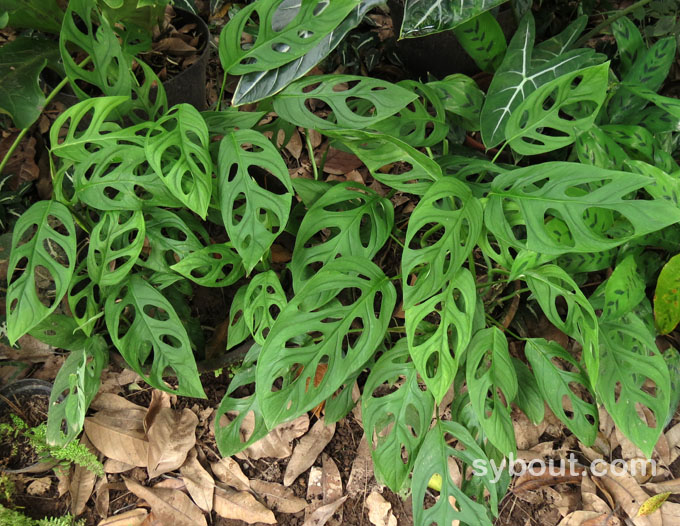
The Five Holes Plant is a family member of the Swiss Cheese Plant described above here.
The Five Holes Plant in the photo has 15 cm - 20 cm long leaves, which each have 5 - 7 holes. The plant has its origin in South and Central America.
If given some support, the plant can climb up to 2 - 4
m. The plant in my garden creeps in and around its pot.
Some people like to prune their potted plant regularly to give it a compact shape.
The Five Holes Plant likes shade or partial shade and a good draining soil. It doesn't need special care, but doesn't like it when the soil is dry for a long time. The leaves and aerial roots of climbing plants need watering by spraying.
Propagation is by stem cuttings. The first new leaves will appear after about 3 weeks.
I found many sources that give this plant the scientific name "Monstera obliqua". Some scientist say that Mostera obliqua actually is a different species that is far less common.
Oak Leaf Philodendron
Latin: Philodendron pedatum
Family: Araceae
English: Oak Leaf Philodendron
Indonesian: Philodendron Merpati
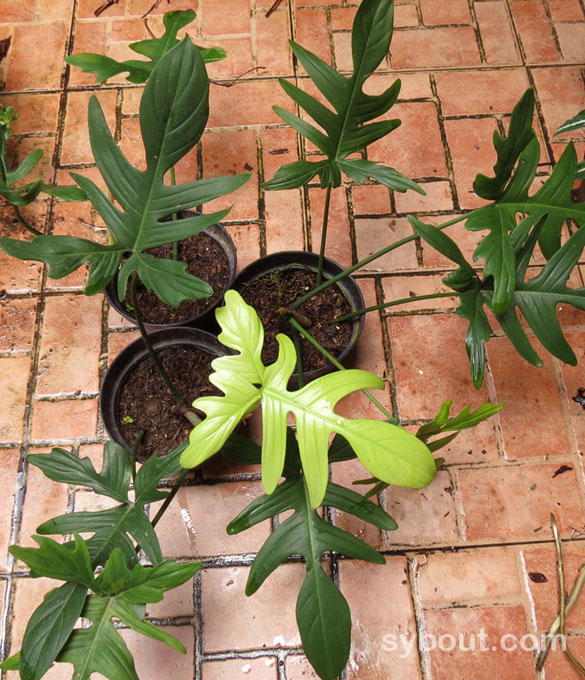
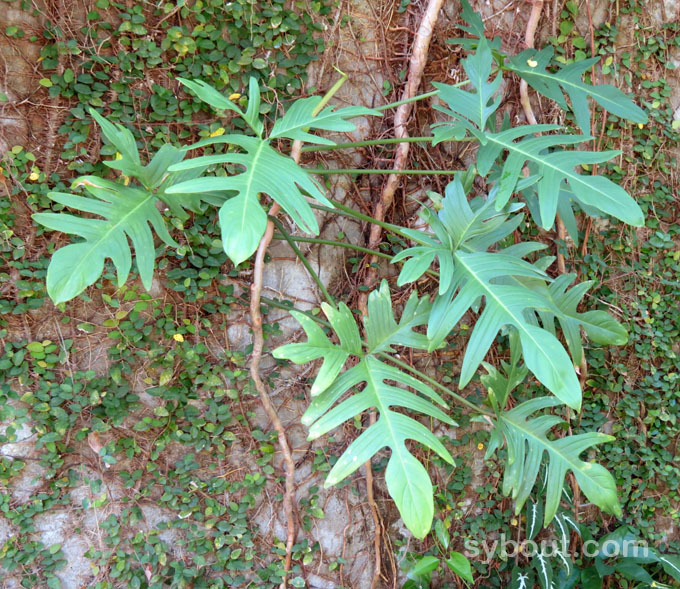
I am still not hundred percent certain if the Oak Leaf Philodendren I have actually is a Philodendron pedatum.
Probably the confusion is created by the fact that this
genus has varying leaf shapes.
The Oak Leaf Philodendron origins from tropical South America. In my garden it grows well in a full, or half shaded place. It can climb a wall up to 3 meters high.
This philodendron is easy to propagate via cuttings.
Bleading Heart Vine
Latin: Clerodendrum thomsoniae
Family: Verbenaceae
Indonesian: Nona Makan Sirih
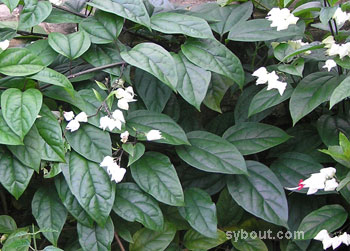
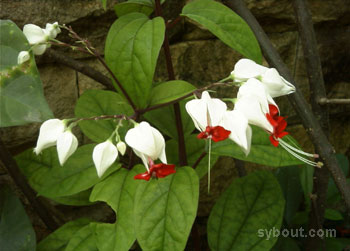
The Bleading Heart Vine has dark
green ovate leaves and has sprays of flowers with large white
calyces and bright red petals. It thrives well in shade and will
need trellis or a shrub as support, as it does not develop tendrils
or sticky roots.
During the dry season the Bleeding Hear Vine in my garden is not that conspicuous as many
of its leaves die and there are no flowers. As soon as the rainy
season starts it develops new branches and leaves and starts
flowering again. It climbs up a trellised fence, but has regularly
been helped by twining its branches in order to keep it in shape.
Garlic Vine
Latin: Mansoa alliacea (Pseudocalymma alliaceum
Family: Bignoniaceae
Indonesian: (unknown)
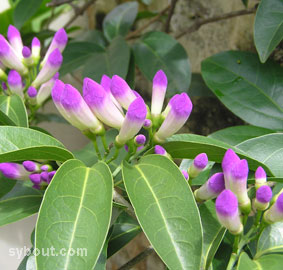
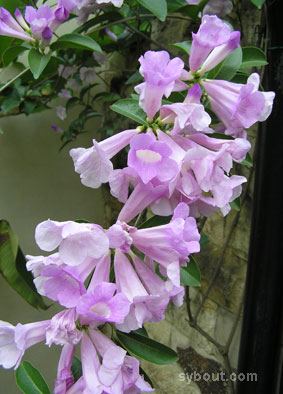
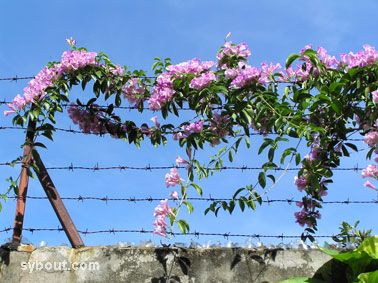
As all parts of this beautiful climber smell
like garlic, it is clear where its English name came from. Usually
you will only notice the odor when you crush its leaves or prune its
branches. When the plant is in full bloom though, the smell will be
strong, especially after the flowers become wet with rain. If you
are not a favorite of garlic you better do not plant this vine near
a door or window that is often opened. If you like garlic you could
use the leaves as a food flavor like is a practice in the Amazon
rainforest.
The vines of the Garlic Vine attach itself with
strong twining tendrils. The leaves are bright
green and up to 15 cm long. The flowers are first beautiful deep lavender
and have a white throat. Later the flowers fade to a pale lavender
and finally become almost
white. All three flower colors can be found on the plant
simultaneously.
In my garden this vine grows vigorously and
has to be pruned regularly. After it climbed a 3 meter high wall I
thought it had done a really good job. But later it spread on top to
the wall and found the water tower as a support. Finally it reached
a length of 12 meters and still would go on if there would be a
higher support.
Abundant bloom finds place two or more times
during the rainy season. In other months incidental clusters of
flowers appear. The flowers are regularly visited by sunbirds
looking for nectar.
Trumpet Vine
Latin: Thunbergia grandiflora
Family: Acanthaceae
English: Trumpet Vine, Sky Vine, Bengal Trumpet
Indonesian: Bunga Madia
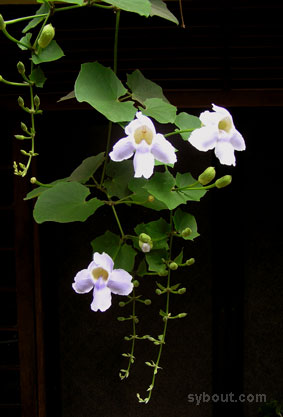
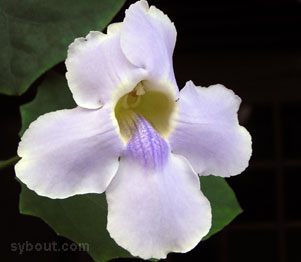
This member of the Acanthaceae family is
popular because of its large flowers that depending on variety vary
from white or light blue to mauve. These grow in clusters on
drooping branches of the vine and have a diameter of about 7 cm.
The individual flowers usually do not last longer than a single day,
but every day other flowers in the clusters will open. Thunbergia grandiflora has heart-shaped leaves with a rough surface.
It is suitable for growing on top of a fence or along trellis or
wire. It likes a sunny or partially shaded place.
In some
areas in the tropics this plant seems to be inclined to become
a weed, because of easily growing
root pieces. I do not know of any cases in Indonesia.
First it was hard
for me to understand the supposed vigorous growth of this plant, as it started slow. But now it is well
established I witness it myself and even think the plant might have been
the inspiration for the violently growing vine in the movie "Jumanji".
With regular intervals new shoots appear from the ground around the
mother plant and if not pulled out, these gain within a couple of weeks a length of several
meters. The older the plant becomes, the further away the new shoots
appear.
Creeping Fig
Latin: Ficus pumila
Family: Moraceae
English: Creeping Fig, Climbing Fig
Indonesian: Daun dolar rambat
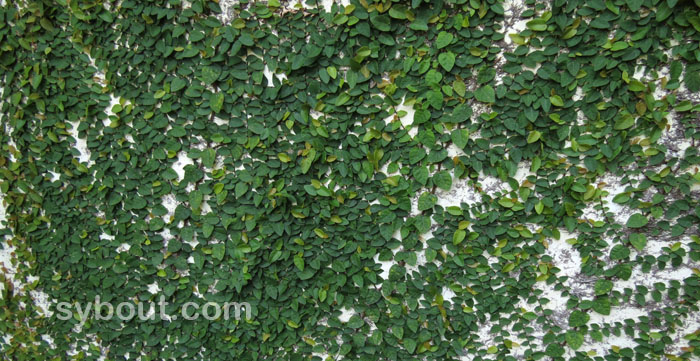
The Creeping Fig is native to China, Japan, and Taiwan. It is a very suitable to give a nice green look to walls. The plant sticks without any help to walls and tree trunks. The Creeping Fig likes full sun to partial shade, but will survive as well in full shade.
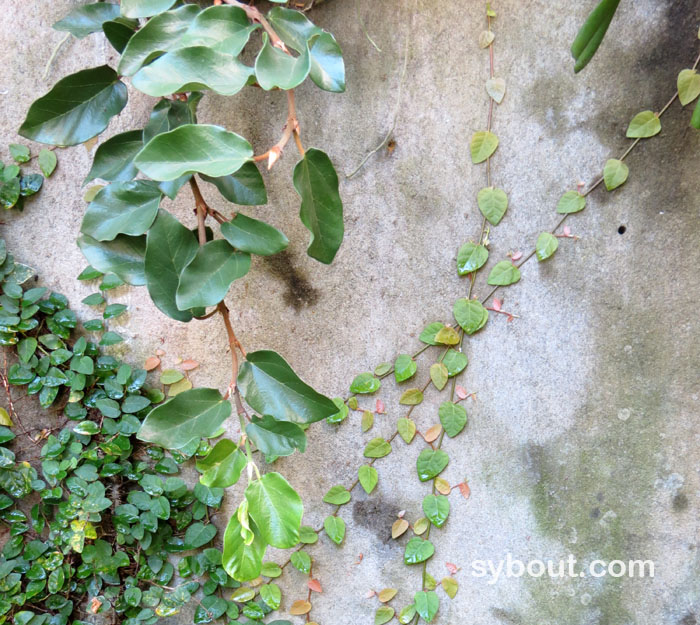
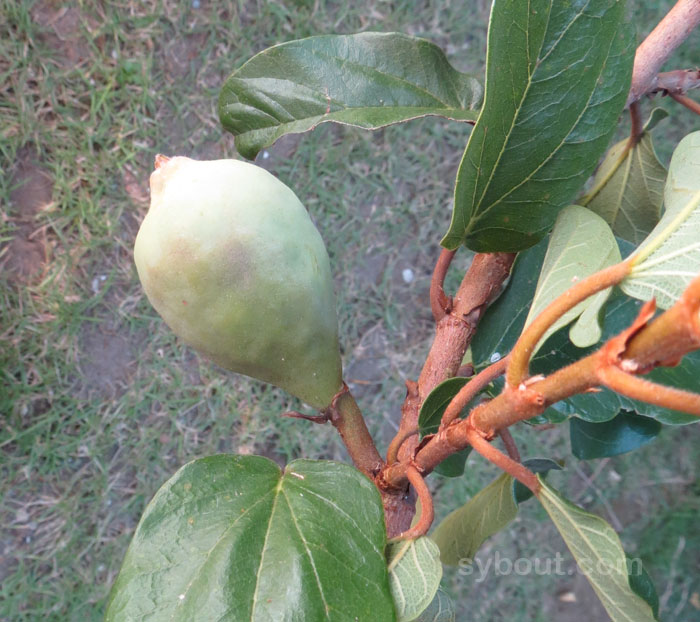
In my garden the Creeping Fig was a slow starter, but became slightly invasive after 3 - 4 years. Older plants tend to creep over the ground to other places and root there. With regular pruning the plants can easily be controlled though.
The Creeping Fig easily climbs up to 4 meters, and probably can grow much higher than that.
Young and adult leaves have different size and shape. The juvenile form has small, heart-shaped, alternate leaves on the vine with roots that stick to the wall. The adult form has larger, more elliptic, more leathery leaves.
Branches with adult leaves stick out (do not stick to the wall) and sometimes bear fruits that have a typical fig shape.
Propagation is easily done by stem cuttings. Around older plants you will find creeping branches on the ground that have rooted already.
I was surprised to read somewhere that the sap of the plant can cause skin inflammation including blisters in combination with sun light (ultraviolet light). I never had problems, though I often have pruned this climber on a sunny day.
It seems that the people who experienced these problems used the
leaves of the Creeping Fig in a skin treatment mixture.
Shingle Vine species
Latin: Rhaphidophora hayi
Family: Araceae
English: Shingle Vine
Indonesian: Dollar rambat besar
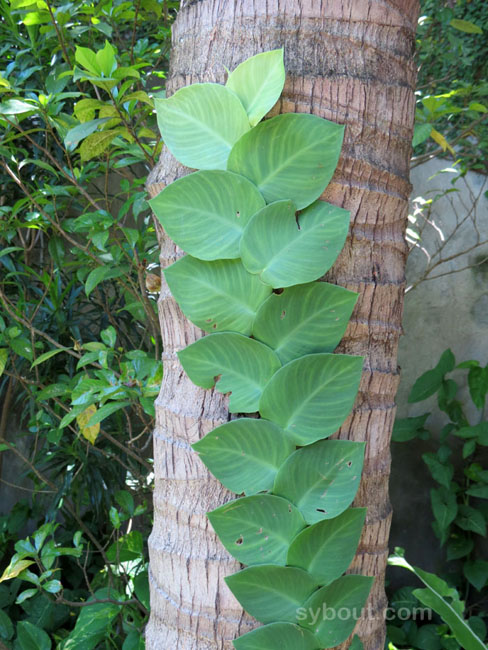
Rhaphidophora hayi is a very decorative vine when planted in a
place where it can climb a tree, post or wall. It will attach itself with aerial roots.
The plant is native to tropical Asia.
Rhaphidophora hayi is easily propagated by stem cuttings. New leaves
growing from the cutting will be around 3 cm in size. When the
plant gets enough light (but not to much direct sun) and the
leaves will be sprayed at least once a day, it will later develop leaves of around 10 - 15 cm.
This shingle vine can reach a height of 4 meters, and probably more.
Pothos
Latin: Epipremnum pinnatum 'Aureum'
Family: Araceae
English: Pothos, Variegated Philodendron
Indonesian: Sirih Gading
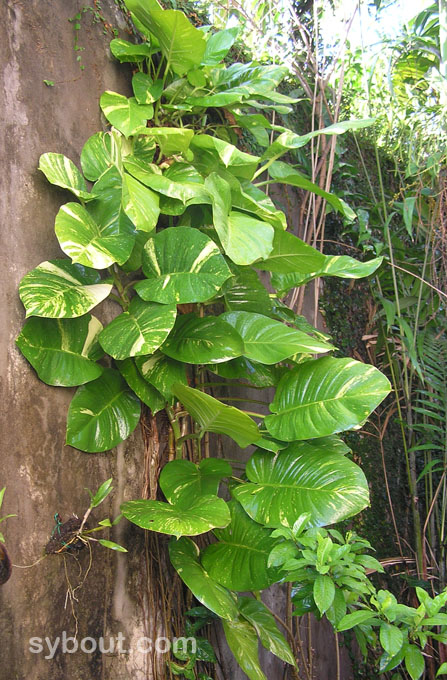
Pothos is a plant that is easily propagated by cuttings and is as well easily cultivated. Probably most people living outside the
tropics know it as a indoor pot plant. In the tropics it is often used as
ground cover under trees and shrubs, because it grows well in the shade.
Once the plant finds a tree or wall for support it will climb and
develop leaves that are more than ten times bigger and more oval shaped than the initial
heart-shaped leaves of the plants creeping on the ground. Plants that grow high up may develop split leaves.
Pothos leaves are yellow and white marbled. Coloring will vary with the amount of light received and with the age of the
leaves. Though Pothos likes shade it can stand full sun for a
part of the day. At the change from the rainy to the dry season its leaves may burn and
wither, but soon new leaves will develop.
The plant in the
picture above grows against a wall and has leaves of about 40 cm in
length. Its has developed roots that stick to the plaster. The
plant has to be pruned regularly to avoid overgrowing of the plants
around it.
